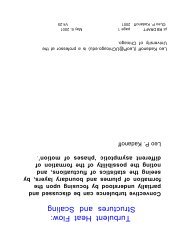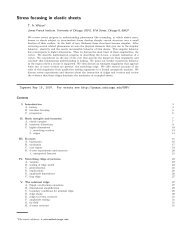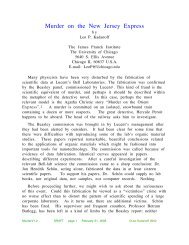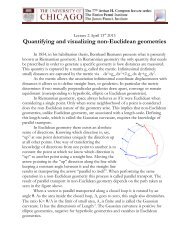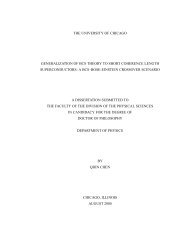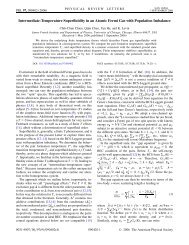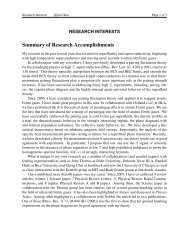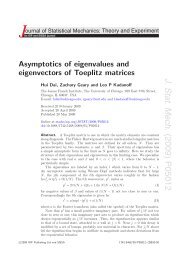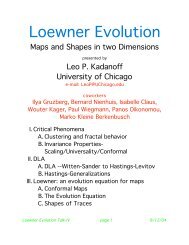Slides Week 9 - James Franck Institute - University of Chicago
Slides Week 9 - James Franck Institute - University of Chicago
Slides Week 9 - James Franck Institute - University of Chicago
Create successful ePaper yourself
Turn your PDF publications into a flip-book with our unique Google optimized e-Paper software.
The 77 th Compton lecture series<br />
Frustrating geometry:<br />
Geometry and incompatibility shaping the physical world<br />
Efi Efrati<br />
Simons postdoctoral fellow<br />
<strong>James</strong> <strong>Franck</strong> <strong>Institute</strong><br />
The <strong>University</strong> <strong>of</strong> <strong>Chicago</strong><br />
Lecture 9:<br />
Fractal geometry<br />
1
Outline:<br />
• What are fractals ?<br />
• Brief history <strong>of</strong> fractals<br />
• The Mandelbrot set<br />
• Fractals in nature and a practical fractal<br />
2
What are fractals ?<br />
3<br />
Properties <strong>of</strong> fractals:<br />
• Features in multiple scales<br />
• Self-similar<br />
• Fractional dimension<br />
• Irregularity
Brief history <strong>of</strong> fractals<br />
Koch curve<br />
4
9a=A=8a<br />
a=0<br />
Brief history <strong>of</strong> fractals<br />
Sierpinski carpet<br />
5
Pierre Fatou<br />
Brief history <strong>of</strong> fractals<br />
6<br />
Gaston Julia<br />
Multiple iterations <strong>of</strong> a function F(z):<br />
F(z), F(F(z)), F(F(F(z))), F(F(F(F(z)))), F(F(F(F(F(z)))))<br />
If all the infinite points generated iteratively from a point P are<br />
contained in a bounded domain, then P is in the Julia set <strong>of</strong> F.
Pierre Fatou<br />
Brief history <strong>of</strong> fractals<br />
7<br />
Gaston Julia<br />
Multiple iterations <strong>of</strong> a function F(z):<br />
F(z), F(F(z)), F(F(F(z))), F(F(F(F(z)))), F(F(F(F(F(z)))))<br />
If all the infinite points generated iteratively from a point P are<br />
contained in a bounded domain, then P is in the Julia set <strong>of</strong> F.
Brief history <strong>of</strong> fractals<br />
Hausdorff Dimension<br />
N(r) = # <strong>of</strong> balls <strong>of</strong> size r needed to cover the object ~ 1/r D<br />
8
hich completely annihilates all linear birefringent an<br />
Brief history <strong>of</strong> fractals<br />
chroic effects. Last we note that the maximal circ<br />
r polarization effects Hausdorff per-scatterer Dimension read only 2/3 <strong>of</strong> th<br />
lue for a single scatterer. Therefore the result <strong>of</strong> this a<br />
N(r) = # <strong>of</strong> balls <strong>of</strong> size r needed to cover the object ~ 1/r D<br />
ngement should be interpreted as selective attenuatio<br />
undesired effects rather than an increase in response<br />
rcular polarization. As this is the result <strong>of</strong> a geometr<br />
inciple it is independent <strong>of</strong> frequency.<br />
r → r/2 ⇒ N → 2N<br />
D=1<br />
9
Brief history <strong>of</strong> fractals<br />
Hausdorff Dimension<br />
N(r) = # <strong>of</strong> balls <strong>of</strong> size r needed to cover the object ~ 1/r D<br />
10
ich completely annihilates all linear birefringent a<br />
Brief history <strong>of</strong> fractals<br />
chroic effects. Last we note that the maximal cir<br />
Hausdorff Dimension<br />
r polarization effects per-scatterer read only 2/3 <strong>of</strong> t<br />
N(r) = # <strong>of</strong> balls <strong>of</strong> size r needed to cover the object ~ 1/r D<br />
lue for a single scatterer. Therefore the result <strong>of</strong> this<br />
ngement should be interpreted as selective attenuat<br />
undesired effects rather than an increase in response<br />
cular polarization. As this is the result <strong>of</strong> a geomet<br />
inciple it is independent <strong>of</strong> frequency.<br />
r → r/2 ⇒ N → 4N<br />
D=2<br />
11
Lewis Fry Richardson<br />
Brief history <strong>of</strong> fractals<br />
12<br />
Coast-line paradox<br />
Total length increases without bound with resolution
Brief history <strong>of</strong> fractals<br />
Hausdorff Dimension<br />
N(r) = # <strong>of</strong> balls <strong>of</strong> size r needed to cover the object ~ 1/r D<br />
D= 1.25<br />
13
Brief history <strong>of</strong> fractals<br />
Hausdorff Dimension<br />
N(r) = # <strong>of</strong> balls <strong>of</strong> size r needed to cover the object ~ 1/r D<br />
D= 1.26 D= 1.1<br />
14
Benoit Mandelbrot<br />
Brief history <strong>of</strong> fractals<br />
Worked for IBM research for 35 years (until 1987)<br />
Tenured at Yale at the age <strong>of</strong> 75 (1999)<br />
15<br />
F(z)=z 2 +c<br />
X(x,y)=x 2 -y 2 +cx<br />
Y(x,y)= 2xy+cy
Benoit Mandelbrot<br />
The Mandelbrot Set<br />
16
Benoit Mandelbrot<br />
The Mandelbrot Set<br />
17
The Mandelbrot Set<br />
First computer image <strong>of</strong> the Mandelbrot (Matelski,1978)<br />
18
The Mandelbrot Set<br />
19
The Mandelbrot Set<br />
20
The Mandelbrot Set<br />
21
Self similar<br />
Exhibit features at all scales<br />
Infinitely refinable<br />
Its boundary has<br />
fractal dimension 2<br />
The Mandelbrot Set<br />
22
principle it is independent <strong>of</strong> frequency.<br />
The Mandelbrot Set<br />
F (z) =z 2 + c<br />
23
Fractals in nature<br />
24
Fractals in nature<br />
Dendritic crystals<br />
25<br />
The edge <strong>of</strong> a torn plastic sheet
Diffusion limited aggregation<br />
Tom Witten and Len Sander<br />
26<br />
D~1.7
Electric discharge: Lichtenberg figure<br />
27<br />
D~1.7
Electric discharge: Lichtenberg figure<br />
28<br />
D~1.7
Lung surface area<br />
D= 2.97<br />
29
Cell phone broad band antenna<br />
Cell phones need to communicate over a wide range <strong>of</strong> frequencies<br />
4G frequency ~ 2.7 GHz, 1.9 GHz<br />
GSM frequency ~ 1.9 GHz, 850 MHz<br />
WiFi frequency ~ 20 MHz, 40MHz<br />
30
Summary<br />
Fractals are objects <strong>of</strong> exotic geometry<br />
They arise naturally in many iterative processes, and scale free processes<br />
Analyzing such structures calls for specialized tools<br />
31
The 77 th Compton lecture series<br />
Frustrating geometry:<br />
Geometry and incompatibility shaping the physical world<br />
Geometry and frustration<br />
Efi Efrati<br />
Simons postdoctoral fellow<br />
<strong>James</strong> <strong>Franck</strong> <strong>Institute</strong><br />
The <strong>University</strong> <strong>of</strong> <strong>Chicago</strong><br />
32
Lecture series overview:<br />
Geometry and frustration<br />
• Geometric shaping principles govern the form and<br />
function <strong>of</strong> much <strong>of</strong> our surrounding world.<br />
• Geometric frustration (local property) leads to rich and<br />
exotic (global) response.<br />
33
Lecture series overview:<br />
Geometry and frustration<br />
• Euclid’s postulates<br />
• Elimination <strong>of</strong> the fifth postulate: Non Euclidean geometry<br />
• Generalized the notion <strong>of</strong> straight lines<br />
34<br />
Lecture 1
Lecture series overview:<br />
Geometry and frustration<br />
• Riemannian geometry<br />
The metric, Parallel transport, Riemannian curvature<br />
• Realizing non-Euclidean geometries:<br />
paper model, crochet, Poincare disc<br />
ds 2 = dx i dx j gij<br />
Elliptic geometry cutout:<br />
Cut the strips. Tape together the appropriate<br />
edges (noted by the same number), red to<br />
blue. Note that the turning rate decreases to<br />
zero and even changes sign.<br />
1<br />
1<br />
instability. I followed the notation<br />
1<br />
<strong>of</strong> Chernikova,<br />
2<br />
2<br />
3<br />
3<br />
4<br />
5<br />
4 5<br />
ding a similar logic). There’s<br />
Hyperbolic ageometry paper<br />
cutout:<br />
by her (Sov.<br />
Cut the strips. Tape together the<br />
appropriate edges red to blue.<br />
Note that the turning rate is constant<br />
6) in which I believe she works things out in detail.<br />
et it from the library.<br />
sense <strong>of</strong> it is by adapting the electron density to<br />
35<br />
1<br />
1<br />
1<br />
2<br />
1<br />
2<br />
2<br />
3<br />
2<br />
3<br />
3<br />
4<br />
3<br />
4<br />
4<br />
4<br />
5<br />
5<br />
5<br />
5<br />
Lecture 2
Lecture series overview:<br />
Geometry and frustration<br />
• Relating intrinsic geometry and shape<br />
• Thin sheet elasticity and isometries<br />
• Shaping by metric prescription<br />
neralize conclusions to more<br />
plex systems.<br />
Front Side<br />
36<br />
Plastic<br />
Violet<br />
Beet<br />
Lettuce<br />
Is there a connection?<br />
Lecture 3
! Differential growth<br />
Lecture series overview:<br />
Geometry and frustration<br />
• Residual Geometric stress frustration in plants and residual stress<br />
• Visualizing residual stress<br />
• Properties <strong>of</strong> residually stressed materials<br />
Tuesday, November 17, 2009<br />
Rhubarb: Rheum rhabarbarum<br />
Tissue tension Brucke 1848<br />
Green grows faster than red.<br />
So red is in tension, green is in compression<br />
This stress is called residual stress.<br />
37<br />
Lecture 4
Lecture series overview:<br />
Geometry and frustration<br />
• Theory <strong>of</strong> crystals, wallpaper symmetries<br />
• Crystallographic restriction<br />
• Penrose tiling<br />
• Quasicrystals<br />
L! L! L!<br />
S! S! L! S! L!<br />
38<br />
Lecture 5
Lecture series overview:<br />
Geometry and frustration<br />
• Knot theroy<br />
• Vortex knots<br />
• Coherence from topology<br />
40<br />
Saturday, May 18, 2013<br />
Peter Tait’s Table <strong>of</strong> Knots<br />
Lecture 7
Lecture series overview:<br />
Geometry and frustration<br />
tion. In this work we study the simultaneous<br />
confinement and incompatibility.<br />
a + b a<br />
= = Φ<br />
• Exotic mathematical a properties b<br />
• Phylotactic patterns<br />
• Fibonacci spirals and golden rectangles<br />
Φ = 1+√ 5<br />
2<br />
=1.618033988...<br />
. DEFINITION OF THE PROBLEM<br />
nsider a thin elastic disc to which a wedge <strong>of</strong><br />
was added (or removed). This constitutes a non-<br />
41<br />
Lecture 8<br />
tu<br />
s
Lecture series overview:<br />
Geometry and frustration<br />
• Fractals: A different kind <strong>of</strong> geometry<br />
42<br />
Lecture 9
The 77 th Compton lecture series<br />
Frustrating geometry:<br />
Geometry and incompatibility shaping the physical world<br />
Thank you<br />
Efi Efrati<br />
Simons postdoctoral fellow<br />
<strong>James</strong> <strong>Franck</strong> <strong>Institute</strong><br />
The <strong>University</strong> <strong>of</strong> <strong>Chicago</strong><br />
43



